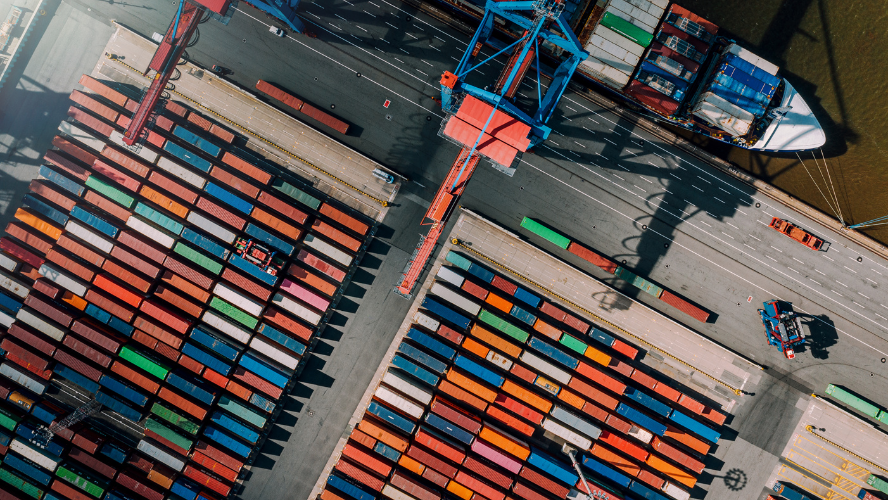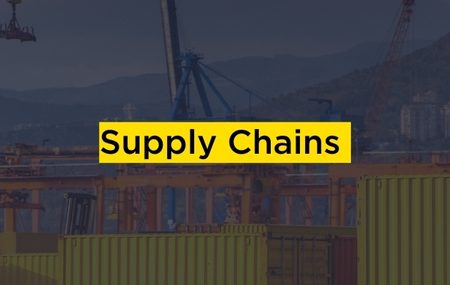Global supply chain strategies have undergone a marked shift in the past five years, reflecting a period defined by continuous disruption.
The Covid-19 pandemic was the catalyst, triggering factory shutdowns, port congestion, labour shortages and sudden shifts in consumer demand. It also exposed vulnerabilities in just-in-time models and over-reliance on single-source suppliers.
In the years that followed, successive crises – from the 2021 Suez Canal blockage to Russia’s 2022 invasion of Ukraine, attacks on Red Sea vessels and extreme weather events – have strained global supply networks.
This has prompted a strategic pivot. Resilience has overtaken efficiency as the top priority for supply chain leaders – which has significant implications for corporate and real estate decision-making.
So what are the dominant risks? And how are they driving change?
Three growing risks to global supply chains
1. Geopolitical uncertainty
Geopolitics is once again shaping supply chain strategy in a way not seen for decades. The current environment – defined by rising protectionism, shifting trade alliances and mounting regional tensions – is forcing industrial and logistics businesses to rethink how and where they operate.
Average US import tariff
Source: Savills Research using Macrobond, PIIE and The Budget Lab at Yale
Global tariff activity is at its highest level since the 1930s, disrupting long-established trade norms. Regional conflict adds further complexity: the war in Ukraine has altered trade flows across Europe, while the Red Sea crisis has forced vessels to reroute via the Cape of Good Hope, significantly increasing costs.
Jack Harkness, Director, Regional Industrial and Logistics Services, Savills Asia, explains: “As these challenges unfold, companies continue to adapt their locational strategies. Many are nearshoring or reshoring production to reduce geopolitical exposure and shorten supply chains.
“Those heavily reliant on Chinese manufacturing are increasingly adopting China+1 models, expanding operations into countries such as Vietnam and India to reduce single-market dependency on China. These shifts often require new warehousing and logistics hubs, generating demand for industrial real estate.”
Have you seen changes in locational strategies among industrial and logistics occupiers in your market over the past 12 months?
Source: Savills survey of global network of industrial and logistics specialists, April 2025
In the US, tariff policy may lead to increased reshoring for some sectors. According to Gregg Healy, Executive Vice President, Head of Industrial Services, Savills North America: “These processes are complex, time-consuming and dependent on the unique dynamics of each industry and company.
“Success requires a robust industrial ecosystem – necessitating investment, modern infrastructure and a skilled workforce, albeit automation is playing a growing role in addressing workforce constraints.”
According to the same survey, 80% of respondents across 54 markets reported leasing delays due to geopolitical uncertainty. Sam Quellyn-Roberts, global occupier services director, EMEA logistics markets at Savills explains, “in the real estate market, caution is translating into slower decision-making”. He adds: “For those proceeding with new leases, flexibility has become key. Shorter leases, break clauses and expansion rights are increasingly common, enabling businesses to stay agile as conditions evolve.”
How has tenant behaviour changed in the past 12 months in your market, in light of more uncertain geopolitical and economic conditions?
Source: Savills survey of global network of industrial and logistics specialists, April 2025
2. Climate volatility
The World Economic Forum’s Global Risks Report 2024 ranked extreme weather as the second most severe global risk – yet the same report found that only 28% of companies surveyed said they had diversified their supplier base to mitigate this risk. This disconnect underscores a key challenge for supply chain resilience.
Recent Savills research has identified global climate-related risk to real estate. Key trade hubs in Asia Pacific are most at risk from typhoons, storm surges and floods, with typhoons repeatedly shutting down major ports like Shanghai.
In Europe, flooding presents significant risk – as seen in Germany in 2021, when severe floods caused major disruption to warehouses and freight corridors. Wildfires in North America and Australia have also disrupted supply chains in recent years.
Beyond extreme weather, climate stress – such as prolonged droughts or rising sea levels – is putting pressure on established trade routes. The Panama Canal drought, for example, has led to reduced throughput capacity and increasing shipping costs for one of the world’s most important east-west trade corridors.
An emerging concern is the phenomenon of climate “flips”, where weather patterns shift from wet to dry, or vice versa. A 2025 WaterAid report highlights Egypt as a case in point: over the past four decades, the country has transitioned from wetter to more extreme dry conditions, fuelling more intense sandstorms. These conditions may have contributed to the 2021 Suez Canal blockage and are expected to increase in frequency.
In response to rising climate risks, trade routes with greater climate resilience are being prioritised, underpinned by growing investment in more resilient logistics infrastructure. Significant funding is being directed towards future-proofing key hubs – for example, the Port of Vancouver’s $7 million climate adaptation programme, and the Port of Rotterdam’s $8.6 million infrastructure upgrade to enhance resilience against extreme weather and sea-level rise.
Location is also key. Sites with multimodal access – allowing for rapid switching between road, rail, air and sea – offer critical flexibility. In Savills What Occupiers Want survey, proximity to transport hubs with multimodal connectivity ranked as the number one global site selection priority for logistics occupiers.
What do occupiers want in site selection?
Source: Savills survey of global network of industrial and logistics specialists, April 2025
3. Digital vulnerability (cyber security)
The same survey shows that digital connectivity and smart building features are also top site priorities. But as supply chains digitise, their vulnerability to cyber threats increases.
The growing use of automated systems, real-time data and internet of things devices has expanded the threat of cyber-attacks. Recent years have seen high-profile disruptions across logistics networks. In 2021, a ransomware attack on Colonial Pipeline disrupted fuel distribution across the US East Coast. More recently, cyber-attacks have targeted warehouse management systems and transport booking platforms, causing temporary shutdowns and exposing businesses to financial and reputational risk.
As supply chains integrate AI, security risks will increase. In response, businesses are reinforcing their cyber resilience strategies through backup systems, network segmentation and supply chain mapping software to track digital dependencies and risks.
For real estate, this means factoring cyber security into both building design and operational planning. Smart warehouses and connected logistics hubs bring efficiency but require strong defences. Landlords, tenants and developers will need to collaborate to ensure facilities are both physically and digitally resilient.
Building resilience and flexibility into supply chains
Geopolitical uncertainty, climate volatility and digital threats are reshaping the global logistics landscape. For businesses, the challenge is moving goods efficiently in an age of constant disruption. For the real estate sector, it calls for new levels of flexibility, optionality and risk planning.



